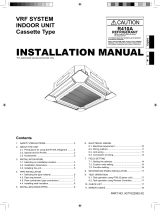
En-2
1. SAFETY PRECAUTIONS
• Be sure to read this Manual thoroughly before installation.
• The warnings and precautions indicated in this Manual con-
tain important information pertaining to your safety. Be sure
to observe them.
• Hand this Manual, together with the Operating Manual, to
the customer. Request the customer to keep them on hand
for future use, such as for relocating or repairing the unit.
WARNING
This mark indicates procedures which,
if improperly performed, might lead to
the death or serious injury of the user.
Request your dealer or a professional installer to install the
indoor unit in accordance with this Installation Manual. An
improperly installed unit can cause serious accidents such
as water leakage, electric shock, or fi re. If the indoor unit is
installed in disregard of the instructions in the Installation
Manual, it will void the manufacturer’s warranty.
Do not turn ON the power until all work has been complet-
ed. Turning ON the power before the work is completed can
cause serious accidents such as electric shock or fi re.
If refrigerant leaks while work is being carried out, ventilate
the area. If the refrigerant comes in contact with a fl ame, it
produces a toxic gas.
Installation work must be performed in accordance with
national wiring standards by authorized personnel only.
This appliance is not intended for use by persons (including
children) with reduced physical, sensory or mental capabili-
ties, or lack of experience and knowledge, unless they have
been given supervision or instruction concerning use of the
appliance by a person responsible for their safety. Children
should be supervised to ensure that they do not play with
the appliance.
CAUTION
This mark indicates procedures which,
if improperly performed, might possibly
result in personal harm to the user, or
damage to property.
Read carefully all security information before use or install
the air conditioner.
Do not attempt to install the air conditioner or a part of the
air conditioner by yourself.
This unit must be installed by qualifi ed personnel with a
capacity certifi cate for handling refrigerant fl uids. Refer to
regulation and laws in use on installation place.
The installation must be carried out in compliance with
regulations in force in the place of installation and the
installation instructions of the manufacturer.
This unit is part of a set constituting an air conditioner. It
must not be installed alone or with non-authorized by the
manufacturer.
Always use a separate power supply line protected by a cir-
cuit breaker opera-ting on all wires with a distance between
contact of 3mm for this unit.
The unit must be correctly earthed (grounded) and the
supply line must be equipped with a differential breaker in
order to protect the persons.
The units are not explosion proof and therefore should not
be installed in explosive atmosphere.
Never touch electrical components immediately after the
power supply has been turned off. Electric shock may
occur. After turning off the power, always wait 5 minutes
before touching electrical components.
This unit contains no user-serviceable parts. Always consult
authorized service personnel to repairs.
When moving, consult authorized service personnel for
disconnection and installation of the unit.
2. ABOUT THIS PRODUCT
2.1. Precautions for using R410A
refrigerant
WARNING
Do not introduce any substance other than the prescribed
refrigerant into the refrigeration cycle. If air enters the refrig-
eration cycle, the pressure in the refrigeration cycle will
become abnormally high and cause the piping to rupture.
If there is a refrigerant leak, make sure that it does not
exceed the concentration limit. If a refrigerant leak exceeds
the concentration limit, it can lead to accidents such as
oxygen starvation.
Do not touch refrigerant that has leaked from the refriger-
ant pipe connections or other area. Touching the refrigerant
directly can cause frostbite.
If a refrigerant leak occurs during operation, immediately
vacate the premises and thoroughly ventilate the area. If
the refrigerant comes in contact with a fl ame, it produces a
toxic gas.





















